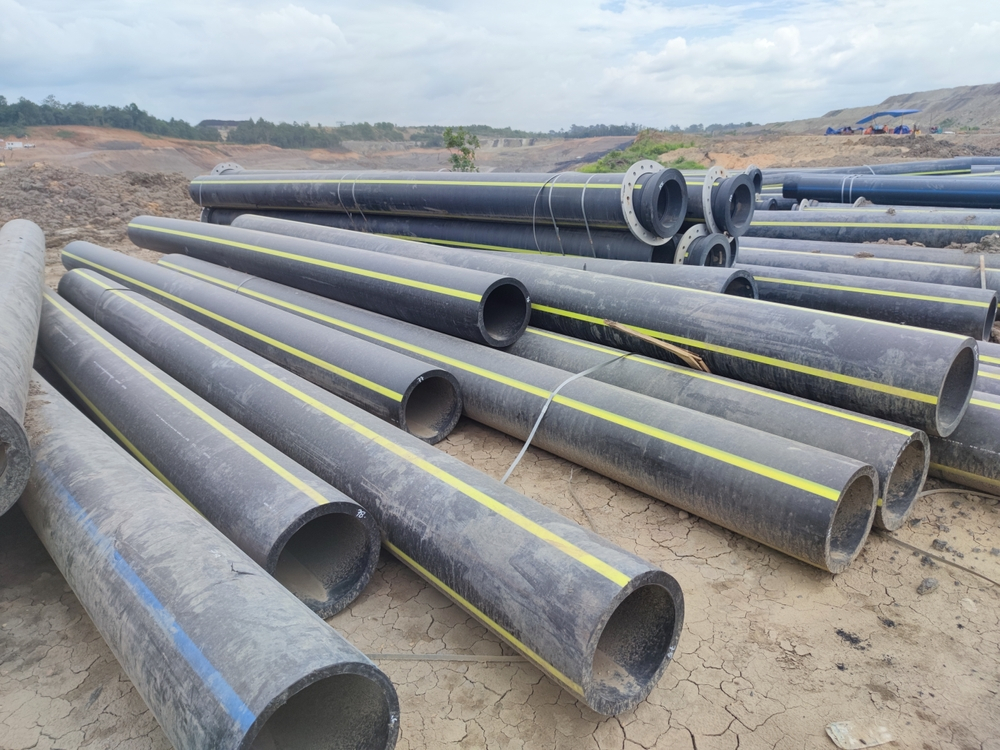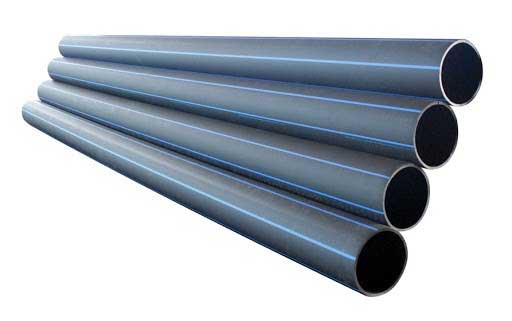How American Plastics HDPE Pipe Manufacturing Maintains Product Consistency
Wiki Article
Discover the Production Refine Behind High-Quality HDPE Pipeline and Its Applications
The production process of high-grade HDPE pipelines is intricate and systematic. It begins with the selection of raw products that boost efficiency. Following this, ethylene undertakes polymerization to develop resin, which is then shaped via extrusion. Quality assurance is vital, making certain that the final item meets strict standards. Nevertheless, the trip of HDPE pipes does not end with production. Their applications across different sectors expose a wider significance worth taking a look at.Understanding HDPE: Qualities and Advantages

High-density polyethylene (HDPE) is a functional thermoplastic known for its toughness and resistance to various environmental variables. This product exhibits excellent tensile strength, making it suitable for demanding applications. Its low-density framework contributes to a lightweight item, assisting in ease of taking care of and setup. HDPE likewise showcases remarkable resistance to chemicals, which reduces destruction when exposed to harsh substances.
The material's low dampness absorption further boosts its longevity, making it perfect for usage in pipes and tank. Additionally, HDPE is immune to ultraviolet (UV) radiation, ensuring that products keep their stability even when revealed to sunshine. In addition, its flexibility enables for the creation of elaborate forms without endangering stamina. The green nature of HDPE, usually stemmed from recycled materials, contributes to its allure, promoting sustainable techniques in manufacturing. Generally, these homes and advantages make HDPE a recommended choice for different commercial and customer applications.
Basic Material Option for HDPE Production
The option of resources for HDPE production is vital to confirm the end product satisfies the desired requirements and high quality criteria. High-density polyethylene (HDPE) is primarily generated from polymerized ethylene, stemmed from fossil fuels such as all-natural gas or petroleum. The top quality of these feedstocks considerably affects the mechanical and thermal buildings of the last HDPE.Ingredients also play a considerable role in improving HDPE's efficiency, consisting of anti-oxidants, UV stabilizers, and colorants, which enhance sturdiness and resistance to environmental elements. The choice process have to consider not only the chemical make-up of the raw products yet likewise their processing attributes to ensure efficient manufacturing.
The sourcing of raw products need to focus on sustainability and conformity with ecological guidelines, as liable practices are necessary in today's market. Eventually, cautious basic material option lays the foundation for creating premium HDPE pipelines ideal for varied applications.
The Extrusion Process: Shaping HDPE Pipe
The extrusion process plays an important function in shaping HDPE pipes, starting with meticulous product prep work techniques that ensure excellent flow and uniformity. Similarly vital is the layout of the die, which straight affects the last dimensions and surface top quality of the pipe. Together, these factors add considerably to the effectiveness and high quality of HDPE pipe production.Product Preparation Techniques
Efficient manufacturing of HDPE pipes begins with precise product preparation methods, particularly the extrusion process. Throughout this phase, high-density polyethylene resin is first dried out to eliminate dampness, making certain perfect flow features. The material is then fed into the extruder, where it goes through home heating and melting, transforming right into a viscous state. This heating process is very carefully regulated to keep the material's honesty and efficiency. The liquified HDPE is forced through a die, forming it into a continual pipe type. Proper temperature monitoring during extrusion is necessary, as it directly affects the product's buildings and the end product top quality. Once shaped, the HDPE pipeline is cooled and reduced to defined lengths, prepared for succeeding handling and applications.Die Layout Importance
Precision in die design plays an important duty in the extrusion procedure of HDPE pipes. The die works as the last shaping tool, directly affecting the pipe's dimensions, wall density, and surface area coating. A well-designed die assurances uniform product circulation, decreasing problems such as irregularities and weak places. The geometry of the die need to be optimized to suit the specific homes of HDPE, including its thickness and thermal habits throughout extrusion. Additionally, the cooling rate of the material as it travels through the die can substantially affect the pipeline's structural integrity. As a result, buying advanced die modern technology is vital for manufacturers intending to produce high-grade HDPE pipes that meet market requirements and client assumptions.Quality Assurance Measures in HDPE Production
Although different aspects affect the top quality of HDPE pipe manufacturing, effective quality assurance actions are crucial to assure uniformity and reliability in the final product. Secret high quality control practices include extensive material assessment, confirming that the raw polyethylene meets established requirements for pureness and density. Throughout the extrusion procedure, specifications such as temperature level, pressure, and cooling time are very closely kept track of to keep dimensional precision and structural honestyOn top of that, post-production testing is crucial; manufacturers frequently carry out hydrostatic examinations to evaluate the pipeline's toughness and resistance to pressure. Visual assessments for surface area flaws additionally enhance high quality guarantee. Certification from relevant standards companies, like ASTM or ISO, offers an added layer of reliability. By carrying out these complete quality assurance measures, producers can decrease flaws, improve efficiency, and ensure that the HDPE pipes meet the particular requirements of numerous applications, eventually bring about consumer fulfillment and trust fund in the product.
Applications of HDPE Pipeline Across Industries
HDPE pipes are used across various sectors because of their resilience and flexibility. In water distribution systems, they assure efficient delivery, while in wastewater administration, they give reputable options for official website waste transportation. In addition, agricultural watering networks gain from HDPE's resistance to deterioration and adaptability, making it a suitable choice for modern farming practices.
Water Distribution Systems
A significant variety of sectors rely on high-density polyethylene (HDPE) pipelines for effective water distribution systems. Known for their toughness and resistance to rust, HDPE pipes are extensively made use of in community supply of water networks, agricultural watering, and industrial applications. Their light-weight nature helps with simple handling and installation, lowering labor expenses and time. Additionally, HDPE pipes can suit numerous pressure degrees, making them appropriate for both reduced and high-pressure systems. Pipe Manufacturing Midland TX. The flexibility of the product permits for seamless assimilation right into existing framework, minimizing the requirement for considerable excavation. Furthermore, HDPE's resistance to chemical seeping warranties that the water provided stays safe and tidy, making it a suitable option for maintaining the high quality of safe and clean water across numerous industriesWastewater Monitoring Solutions
Effective water distribution systems additionally lead the way for innovative wastewater administration remedies, where high-density polyethylene (HDPE) pipes play a considerable duty. Distinguished for their longevity and resistance to rust, HDPE pipes are excellent for moving wastewater in various setups. Their versatility enables simple installment in complex atmospheres, reducing the requirement for extensive excavation. In addition, HDPE's smooth indoor surface area reduces friction, enhancing circulation prices and performance. These pipes are additionally immune to chemical leaching, ensuring that pollutants do not jeopardize the surrounding environment. Industries, municipalities, and therapy centers increasingly count on HDPE pipes for their dependability and long life, making them a preferred choice for modern wastewater administration systems. This versatility emphasizes the essential importance advice of HDPE pipelines across countless applications.Agricultural Irrigation Networks
Agricultural watering networks benefit greatly from making use of high-density polyethylene (HDPE) pipes, which provide effective and reputable water distribution to plants. HDPE pipes are light-weight, making them simple to move and mount, while their versatility enables various setups in diverse terrains. These pipelines show excellent resistance to deterioration, chemicals, and UV radiation, guaranteeing sturdiness in extreme agricultural environments. Additionally, their smooth indoor surface area minimizes friction loss, maximizing water flow and minimizing power prices related to pumping. The longevity of HDPE pipelines, often surpassing 50 years, adds to lower maintenance and replacement expenditures. Farmers significantly count on HDPE pipelines to boost irrigation performance and promote sustainable farming methods, ultimately leading to improved plant yields and resource preservation.
Future Trends in HDPE Pipeline Modern Technology
As the need for lasting and efficient infrastructure grows, innovations in HDPE pipe technology are positioned to change various markets. Arising patterns consist of the assimilation of clever innovations, such as sensors and IoT capabilities, which facilitate real-time tracking of pipeline problems, reducing maintenance expenses and stopping leaks. In addition, the growth of advanced manufacturing strategies, such as 3D printing, is allowing the production of facility, tailored pipeline designs that satisfy specific job needs.The focus on recycling and round economy methods is driving the advancement of HDPE pipes made from recycled materials, improving sustainability. Improved jointing techniques, such as electro-fusion and mechanical installations, are also boosting why not check here setup performance and integrity. Finally, the growing focus on environmental guidelines is pressing makers to embrace greener manufacturing procedures, ensuring that HDPE pipelines not only satisfy sector standards yet additionally promote a more sustainable future for infrastructure advancement.
Often Asked Questions
How Does HDPE Contrast to Other Plastic Products?
HDPE surpasses lots of other plastic materials concerning longevity, chemical resistance, and flexibility. Its low thickness and high tensile stamina make it suitable for different applications, often exceeding options in both performance and longevity.What Are the Ecological Effects of HDPE Manufacturing?
The environmental effects of HDPE manufacturing consist of greenhouse gas exhausts, energy intake, and prospective pollution from making procedures. Furthermore, improper disposal can cause soil and water contamination, raising concerns about lasting ecological impacts.Can HDPE Piping Be Reused?
Yes, HDPE pipes can be recycled. Lots of centers approve used HDPE for processing, changing it right into new items. This reusing contributes to sustainability efforts, lowering plastic waste while conserving resources and energy in the production cycle.What Is the Lifespan of HDPE Water Lines?

Exactly How Do Temperature Level Variations Affect HDPE Pipeline Performance?
Temperature level variants substantially affect HDPE pipe efficiency, affecting adaptability and toughness. Heats can lead to softening, while low temperatures might trigger brittleness, inevitably affecting the pipe's resilience and viability for various applications in varied settings.Report this wiki page